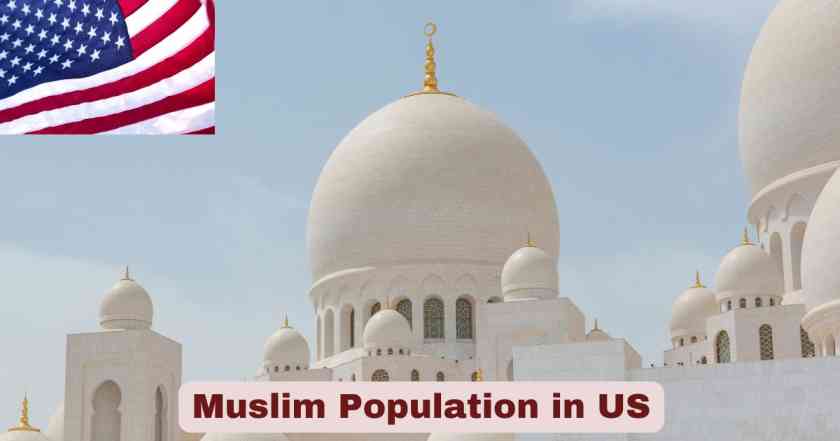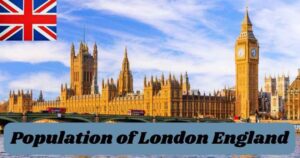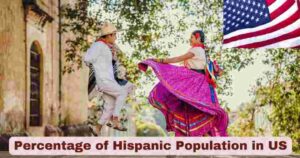Muslim Population in US 2025
The Muslim population in the United States has experienced remarkable growth and transformation over recent decades, establishing itself as one of the nation’s most diverse and dynamic faith communities. According to the 2020 United States Religion Census, approximately 4.5 million Muslims reside across America, representing a vibrant tapestry of ethnic backgrounds, generational experiences, and cultural traditions. This community encompasses individuals from over 80 countries, creating a uniquely American Muslim identity that reflects the nation’s broader immigrant heritage while maintaining deep connections to Islamic faith and practice. The Muslim American population includes approximately one-third African Americans, one-third South Asian Americans, one-quarter Arab Americans, and a growing number of Latino, white, and other ethnic backgrounds, making it the most ethnically diverse religious community in the United States.
The demographic landscape of Muslims in America in 2025 reveals a community characterized by youth, educational achievement, and economic diversity. With 26 percent of Muslims between ages 18 and 24, the Muslim population is significantly younger than other religious groups in America, positioning this community to play an increasingly influential role in the nation’s future. The Muslim American community demonstrates strong commitment to education, with 46 percent holding college degrees or higher, exceeding the national average of 38 percent among the general public. This educational attainment translates into professional success across diverse fields including medicine, engineering, technology, education, and business, with an estimated 50,000 Muslim physicians comprising approximately five percent of the nation’s physician workforce. The community’s geographic distribution centers in major metropolitan areas, with New York State, California, Illinois, and New Jersey hosting the largest Muslim populations, reflecting both historical immigration patterns and ongoing urbanization trends that concentrate Muslim Americans in economically dynamic regions offering employment opportunities and established community infrastructure.
Interesting Stats & Facts About Muslim Population in the US 2025
| Key Muslim Population Facts | Details |
|---|---|
| Total Muslim Population in US 2025 | 4.5 million (2020 US Religion Census estimate) |
| Percentage of US Population | Approximately 1% of total population |
| Most Ethnically Diverse Faith Community | 33% Black, 33% South Asian, 25% Arab descent |
| Youth Demographics | 26% of Muslims aged 18-24 years |
| Educational Attainment | 46% have college degree or higher |
| Muslim Physicians in US | Approximately 50,000 (5% of physician workforce) |
| Born in United States | 42% are US-born Muslims |
| Mosques in America 2025 | 2,771 masjids nationwide |
| Islamic Schools in US | 300 Islamic schools serving 50,000+ students |
| Muslims in US Military | 5,896 active duty service members |
Data Sources: 2020 US Religion Census, Pew Research Center 2023-24 Religious Landscape Study, Institute for Social Policy and Understanding (ISPU), Justice For All 2025 Report
The statistical portrait of Muslim Americans in 2025 reveals a community that defies simplistic categorization, encompassing extraordinary diversity in ethnicity, socioeconomic status, religious practice, and cultural expression. The 4.5 million Muslim population estimate from the 2020 United States Religion Census represents the most comprehensive count available, though estimates vary among different research organizations, with some surveys suggesting figures between 3 to 4.5 million. This variance reflects the inherent challenges in measuring religious populations in America, where the Census Bureau does not collect data on religious affiliation, requiring researchers to rely on surveys, organizational membership records, and demographic modeling techniques that each carry their own methodological limitations and margin of error.
The ethnic diversity within the Muslim American community stands as one of its most distinctive characteristics, with one-third identifying as Black or African American, one-third as South Asian American including Pakistani, Indian, Bangladeshi, and Afghan backgrounds, and one-quarter as Arab American representing countries from Morocco to Iraq. The remaining portion includes white American converts, Latino Muslims representing a rapidly growing demographic, Southeast Asian Muslims from Indonesia and Malaysia, African immigrants from Nigeria, Somalia, and other nations, and smaller communities from virtually every region of the world. This unprecedented diversity creates both opportunities and challenges, as Muslim Americans navigate the complexities of building unified community institutions while honoring the rich cultural traditions that different groups bring to American Islam. The 42 percent of Muslims born in the United States includes both children of immigrants and African American Muslims whose connection to Islam often traces back multiple generations or to conversions within the African American community, creating distinct cultural expressions of Islamic identity that reflect both universal Islamic principles and specific American experiences.
Muslim Population Distribution by State in the US 2025
| Rank | State | Estimated Muslim Population | Percentage of State Population | Major Cities |
|---|---|---|---|---|
| 1 | New York | 724,475 | 3.7% | New York City, Buffalo |
| 2 | California | 504,056 | 1.3% | Los Angeles, San Francisco |
| 3 | Illinois | 473,792 | 3.7% | Chicago, Rockford |
| 4 | New Jersey | 321,652 | 3.5% | Paterson, Jersey City |
| 5 | Texas | 313,209 | 1.1% | Houston, Dallas |
| 6 | Michigan | 241,828 | 2.4% | Dearborn, Detroit |
| 7 | Maryland | 188,914 | 3.1% | Baltimore, Silver Spring |
| 8 | Virginia | 169,371 | 2.0% | Northern Virginia, Richmond |
| 9 | Pennsylvania | 149,561 | 1.2% | Philadelphia, Pittsburgh |
| 10 | Massachusetts | 131,749 | 1.9% | Boston, Worcester |
Data Sources: World Population Review, 2020 US Religion Census, State-level estimates compiled from various research organizations
The geographic distribution of Muslims across American states in 2025 reflects historical immigration patterns, economic opportunity concentrations, and established community networks that facilitate newcomer settlement. New York State leads the nation with an estimated 724,475 Muslims, representing approximately 3.7 percent of the state’s population, with the vast majority concentrated in New York City and surrounding metropolitan areas. The Empire State’s dominance stems from its role as America’s premier immigrant gateway, with Muslims arriving from virtually every Muslim-majority nation finding established communities, diverse employment opportunities, and the critical mass necessary to support religious institutions, halal food suppliers, Islamic schools, and social services that help maintain religious identity in a pluralistic society.
California ranks second with approximately 504,056 Muslims, though this represents only 1.3 percent of the Golden State’s massive population. The Muslim community in California demonstrates notable geographic concentration in Los Angeles, the San Francisco Bay Area, San Diego, and Sacramento, with each region hosting distinct demographic profiles reflecting different immigration waves and economic sectors. Illinois claims third position with 473,792 Muslims, representing 3.7 percent of the state population, with Chicago serving as the primary hub for Midwest Muslim communities. The Windy City’s Muslim population includes significant Arab American communities, South Asian professionals in suburbs, and African American Muslims with deep roots in the city’s history. New Jersey’s 321,652 Muslims comprise 3.5 percent of the state’s population, benefiting from proximity to New York City while offering more affordable housing and family-friendly suburban environments that attract Muslim families seeking quality schools and community infrastructure. Texas hosts 313,209 Muslims, with major concentrations in Houston and Dallas reflecting the state’s economic dynamism, relatively affordable cost of living, and growing diversity that has transformed Texas into a destination for both domestic and international Muslim migration.
Age Distribution of Muslim Population in the US 2025
| Age Group | Percentage of Muslim Population | Comparison to General US Population | Key Characteristics |
|---|---|---|---|
| 18-24 Years | 26% | General US: 10-12% | Significantly younger demographic |
| 25-34 Years | Estimated 22% | General US: 14% | Young professionals, family formation |
| 35-44 Years | Estimated 20% | General US: 13% | Established careers, raising children |
| 45-54 Years | Estimated 15% | General US: 13% | Peak earning years |
| 55-64 Years | Estimated 10% | General US: 13% | Pre-retirement planning |
| 65+ Years | Estimated 7% | General US: 17% | Significantly lower senior population |
Data Sources: Institute for Social Policy and Understanding (ISPU), Pew Research Center, Justice For All 2025 Report
The age distribution within the Muslim American population reveals one of the community’s most striking demographic characteristics: extraordinary youth compared to other religious groups in America. With 26 percent of Muslims falling between ages 18 and 24, compared to only 10 to 12 percent for other surveyed groups, the Muslim population skews dramatically younger than the national average. This youthfulness stems from multiple factors including relatively recent large-scale immigration from Muslim-majority countries beginning in the 1960s following immigration law reforms, higher fertility rates among Muslim families compared to the general American population, and the fact that Muslim immigration continues at substantial levels while immigration from traditionally Christian European countries has declined significantly over recent decades.
The concentration of Muslims in younger age cohorts carries profound implications for the community’s future trajectory and influence in American society. This demographic profile means that Muslim Americans are currently raising families, establishing careers, purchasing homes, starting businesses, and building the institutional infrastructure that will shape the community for generations to come. The relatively small percentage of Muslims over age 65—estimated at only 7 percent compared to 17 percent for the general US population—reflects both the recency of large-scale Muslim immigration and the demographic pyramid structure common in immigrant communities where the first generation is still relatively young. As this population ages over coming decades, the Muslim American community will need to develop eldercare facilities, retirement communities, and social services tailored to Islamic religious and cultural norms, representing both a challenge and an opportunity for community institution-building.
Educational Attainment Among Muslims in the US 2025
| Education Level | Percentage of Muslim Adults | US General Population | Comparison |
|---|---|---|---|
| College Degree or Higher | 46% | 38% | +8 percentage points |
| Graduate or Professional Degree | Estimated 18% | 13% | Higher advanced degree attainment |
| Some College/Associate Degree | Estimated 26% | 29% | Slightly below average |
| High School Graduate | Estimated 22% | 27% | Below average |
| Less than High School | Estimated 6% | 11% | Well below average |
Data Sources: Institute for Social Policy and Understanding (ISPU) American Muslim Poll 2022, Pew Research Center, US Census Bureau General Population Statistics
The educational achievement levels among Muslim Americans significantly exceed national averages, with 46 percent holding college degrees or higher compared to only 38 percent of the general public. This educational attainment reflects multiple factors including immigration policies that have historically favored skilled workers and students, cultural emphasis on education within many Muslim communities, and the necessity for immigrants to acquire credentials and skills to succeed in competitive American labor markets. The Muslim community’s educational success appears particularly concentrated in specific fields, with over 10 percent employed in engineering and information technology and an estimated 8 percent working in medicine-related fields, representing substantial overrepresentation in these high-skill, high-income professions.
The strong educational performance among Muslims in America carries important implications for economic mobility, political influence, and social integration. Higher education levels generally correlate with higher incomes, greater civic engagement, and increased social capital that facilitates community organization and advocacy. However, the aggregate statistics mask significant internal variation within the Muslim American community, with educational attainment varying substantially by ethnicity, generation, and immigration status. For example, South Asian Muslim Americans often demonstrate particularly high educational achievement, while some African American Muslim communities and recent refugee populations face greater educational challenges reflecting broader patterns of racial inequality and the difficulties refugees encounter in credential recognition and language acquisition. The 6 percent of Muslim adults with less than a high school education, though well below the 11 percent national average, represents approximately 270,000 individuals who may face limited economic opportunities and require targeted educational support services.
Income and Economic Status of Muslims in the US 2025
| Income Category | Percentage of Muslim Households | Key Economic Indicators |
|---|---|---|
| $100,000 or More | 22% | Upper middle class and affluent |
| $75,000 – $99,999 | Estimated 18% | Middle class stability |
| $50,000 – $74,999 | Estimated 17% | Working middle class |
| $30,000 – $49,999 | Estimated 10% | Working class |
| Less than $30,000 | 33% | Low income/poverty |
| Muslim Physicians | ~50,000 | 5% of US physician workforce |
| Engineering/IT Employment | 10%+ of Muslim workforce | High-skill concentration |
Data Sources: Justice For All 2025 Report, ISPU American Muslim Poll, Gallup Muslim Americans Report
The economic profile of Muslim Americans in 2025 reveals a community characterized by striking bifurcation, with substantial representation in both affluent professional classes and low-income populations facing economic hardship. Twenty-two percent of Muslim households earn $100,000 or more annually, indicating significant economic success among a meaningful segment of the community, while simultaneously 33 percent of Muslim households subsist on less than $30,000 per year, placing them near or below federal poverty guidelines. This economic stratification reflects the community’s diversity, encompassing both highly educated professionals in medicine, engineering, and technology alongside working-class immigrants in service industries, small business owners struggling with startup challenges, and refugees still establishing economic footing years after arrival.
The presence of approximately 50,000 Muslim physicians in America represents a remarkable achievement, with Muslims comprising an estimated 5 percent of the nation’s physician workforce while constituting only 1 percent of the total population. This five-fold overrepresentation in medicine reflects both the prestige of medical careers in many Muslim-majority cultures and the immigration policies that have facilitated entry for foreign-trained doctors. Beyond medicine, more than 10 percent of Muslim Americans work in engineering and information technology, further demonstrating the community’s concentration in high-skill, knowledge-economy sectors. The entrepreneurial spirit runs strong among Muslim Americans, with more self-employed individuals than the general population, including 96,000 Muslim-owned businesses in New York City alone and 36,000 in Michigan, ranging from small family businesses to major corporations. These economic statistics demonstrate that while many Muslims achieve the American Dream of upward mobility through education and entrepreneurship, significant portions of the community struggle with poverty, requiring both celebration of successes and attention to those facing economic hardship.
Religious Institutions and Islamic Education in the US 2025
| Institution Type | Number in United States | Population Served | Key Functions |
|---|---|---|---|
| Mosques (Masjids) | 2,771 | All Muslims nationwide | Prayer, education, community services |
| Islamic Schools (Full-time) | 300 | 50,000+ students | K-12 Islamic education |
| Weekend Islamic Schools | Offered by 76% of mosques | Tens of thousands of children | Supplementary Islamic education |
| Islamic Seminaries/Madrasas | 8 | Advanced students | Higher Islamic learning, imam training |
| Muslim Colleges/Universities | 4 | Undergraduate/graduate students | Islamic higher education |
| Mosque Weekend Programs | 76% of all mosques | Children and youth | Quran, Arabic, Islamic studies |
Data Sources: Association of Religion Data Archives (ARDA), National Association of Full-time Islamic Schools (NAFIS), Justice For All 2025 Report
The institutional infrastructure supporting Muslim religious life in America has grown substantially over recent decades, with 2,771 mosques now operating across the United States, serving as centers not only for daily and Friday prayers but also for education, social services, community organizing, and civic engagement. These mosques represent diverse architectural styles, administrative structures, and community compositions, ranging from converted houses serving small immigrant communities to purpose-built facilities costing millions of dollars and accommodating thousands of worshippers. The geographic distribution of mosques broadly follows Muslim population concentrations, with the highest densities in New York, California, Illinois, Texas, and Michigan, though mosques can be found in all 50 states including small towns and rural areas where even modest Muslim populations have organized communal worship spaces.
The educational infrastructure extends beyond mosques to include approximately 300 full-time Islamic schools serving more than 50,000 students from kindergarten through 12th grade, offering curricula that combine standard academic subjects required by state education departments with Islamic studies, Quran memorization, and Arabic language instruction. These schools appeal to Muslim families seeking environments where children can maintain Islamic identity while receiving quality education, though they serve only a small fraction of Muslim school-age children, with the vast majority attending public schools. Seventy-six percent of American mosques offer weekend schools where children attend classes on Saturdays or Sundays to learn Quran recitation, basic Islamic beliefs and practices, and Arabic language, supplementing their weekday secular education. The establishment of 8 Islamic seminaries and madrasas for higher education along with three colleges and one university operated by Muslims represents efforts to train American-born religious leaders who understand both Islamic tradition and American cultural context, addressing the historical pattern of importing imams from overseas who often struggle to relate to American Muslim experiences.
Religious Practice and Observance Among Muslims in the US 2025
| Religious Practice | Percentage/Statistics | Comparison/Context |
|---|---|---|
| Friday Prayer Attendance (Almost Weekly) | 38% | Protestants: 44%, Mormons: 67% |
| Friday Prayer Attendance (Detailed Survey) | 9.8% men, 5.3% women | Lower than general estimates |
| Ramadan Fasting | 47% | Core Islamic pillar observance |
| Daily Prayer (5 Times) | Estimated 15-25% | Varies by survey methodology |
| Zakat (Charitable Giving) 2021 | $1.8 billion | Domestic and international causes |
| Conversion to Islam (Illinois) | 25% population growth | 41-61% leave within few years |
Data Sources: Gallup 2023, Ba-Yunus Research, Indiana University Lilly Family School of Philanthropy 2021, Justice For All 2025 Report
The religious observance patterns among Muslims in America reveal substantial variation in practice levels, reflecting the diversity of the community and the challenges of maintaining traditional religious practices in a secular society. Thirty-eight percent of Muslims report attending Friday prayers on an almost weekly basis according to 2023 Gallup data, placing Muslim mosque attendance below Mormons at 67 percent but roughly comparable to Protestants at 44 percent. However, more detailed surveys focusing specifically on Muslim communities suggest considerably lower actual Friday prayer attendance, with one comprehensive study finding only 9.8 percent of Muslim men and 5.3 percent of Muslim women attending weekly Friday prayers, illustrating how survey methodology and social desirability bias can significantly affect reported religious practice statistics.
The observance of Ramadan fasting, one of Islam’s five pillars, engages approximately 47 percent of all Muslims in the United States, representing a core religious practice that many Muslims maintain even when other observances like daily prayers or mosque attendance may lapse. The charitable giving practice of Zakat demonstrates the Muslim American community’s substantial philanthropic engagement, with $1.8 billion donated in 2021 to both domestic causes supporting American communities and international humanitarian work in Muslim-majority countries and refugee populations. The conversion to Islam sees meaningful numbers, with Illinois reporting that approximately 25 percent of Muslim population growth stems from conversions, though this comes with a sobering reality that 41 percent of new Muslims in Illinois and 61 percent in New York leave Islam within a few years, highlighting the challenges of maintaining religious identity without supportive community networks and the difficulties some converts face in navigating cultural differences between American society and immigrant-dominated mosque communities.
Muslim Americans in Professional Fields in 2025
| Professional Sector | Estimated Number/Percentage | Notable Characteristics |
|---|---|---|
| Physicians | ~50,000 (5% of workforce) | Significantly overrepresented |
| Engineering | 10%+ of Muslim workforce | High concentration in tech |
| Information Technology | 10%+ of Muslim workforce | Software, data science, cybersecurity |
| Medicine-Related Fields | 8% of Muslim workforce | Nursing, pharmacy, medical research |
| Business Ownership | Above national average | 96,000 businesses in NYC, 36,000 in Michigan |
| Education | Growing presence | Teachers, professors, administrators |
| Military Service | 5,896 active duty | All branches of armed forces |
| US Congress | 4 members | Legislative representation |
Data Sources: ISPU Report on Muslim Physicians, Ba-Yunus Research, US Department of Defense, Justice For All 2025 Report
The professional distribution of Muslim Americans across various economic sectors demonstrates remarkable concentration in high-skill knowledge economy fields, particularly medicine, engineering, and information technology. The estimated 50,000 Muslim physicians practicing in America represents one of the community’s most striking achievements, with Muslims comprising approximately 5 percent of all physicians while making up only 1 percent of the general population. This five-fold overrepresentation reflects multiple factors including the high status of medical careers in many Muslim-majority cultures, immigration policies favoring skilled professionals, and the substantial numbers of foreign-trained doctors who immigrated to America to practice medicine, often filling crucial gaps in underserved communities.
The engineering and information technology sectors employ more than 10 percent of Muslim Americans, with particular strength in software development, data science, cybersecurity, and various engineering disciplines from electrical to civil engineering. This concentration positions Muslim Americans at the forefront of technological innovation and digital transformation reshaping the American economy. The entrepreneurial spirit runs strong in the Muslim American community, with rates of self-employment exceeding the general population and impressive concentrations of Muslim-owned businesses in major cities. New York City hosts 96,000 Muslim-owned businesses ranging from small corner stores and restaurants to substantial technology firms and professional services, while Michigan claims 36,000 Muslim-owned businesses, many clustered in the Detroit metropolitan area. The presence of 5,896 Muslims serving in the active duty military demonstrates patriotic service to the nation, while four Muslim members of Congress represent growing political engagement and representation, though Muslims remain underrepresented in elected office relative to their population share.
Muslim Population Growth Trends in the US 2025
| Growth Factor | Impact/Statistics | Projections |
|---|---|---|
| Immigration | Primary growth driver | Continuing but variable |
| Birth Rates | Higher than US average | Long-term growth factor |
| Conversion to Islam | 25% of Illinois growth | Offset by apostasy rates |
| Youth Demographics | 26% aged 18–24 | Future family formation |
| Total Population 2017 | 3.45 million (Pew) | Estimated 4.5+ million in 2025 |
| Percentage of US Population | 1% currently | Projected 2.1% by 2050 |
| Geographic Expansion | All 50 states | Dispersing beyond gateway cities |
| Generational Change | 42% US-born | Increasing native-born majority |
Data Sources: Pew Research Center Religious Landscape Study 2017-2024, 2020 US Religion Census, ISPU Research
The growth trajectory of the Muslim population in America reflects multiple demographic dynamics including ongoing immigration, higher-than-average birth rates, religious conversion, and the coming of age of large cohorts of young Muslims born in the United States. Immigration has historically served as the primary engine of Muslim population growth, with substantial numbers arriving as students pursuing higher education, skilled workers recruited by American companies, family members reuniting with earlier immigrants, refugees fleeing conflict and persecution, and diversity visa lottery winners. While immigration levels fluctuate based on policy changes, international conditions, and political climate, the Muslim immigrant flow continues, though at varying rates compared to peak periods in recent decades.
The Muslim population’s exceptional youth, with 26 percent between ages 18 and 24, positions the community for continued growth through natural increase as these young adults form families and have children. Birth rates among Muslim Americans exceed the national average, contributing to population growth even independent of immigration. The Pew Research Center estimated 3.45 million Muslims in America in 2017, while the 2020 Religion Census estimated 4.5 million, and current projections suggest continued growth toward possibly 2.1 percent of the US population by 2050. The increasing proportion of US-born Muslims, currently at 42 percent, represents a fundamental demographic shift from an immigrant-dominated community toward one where American-born Muslims will eventually constitute the majority. This generational transition carries profound implications for Islamic practice, institutional development, political engagement, and the community’s relationship with American society, as native-born Muslims navigate different challenges and opportunities than their immigrant parents and grandparents.
Geographic Distribution and Urban Concentration of Muslims in the US 2025
| Metropolitan Area | Estimated Muslim Population | Percentage of Metro Population | Characteristics |
|---|---|---|---|
| New York City Metro | 600,000 – 700,000 | 3-3.5% | Most diverse Muslim population |
| Los Angeles Metro | 250,000 – 300,000 | 2-2.5% | Iranian, Arab, South Asian |
| Chicago Metro | 400,000 – 450,000 | 4-5% | Arab, South Asian, African American |
| Detroit Metro | 200,000 – 250,000 | 5-6% | Highest percentage, Dearborn hub |
| Houston Metro | 150,000 – 180,000 | 2-2.5% | Diverse, rapidly growing |
| Washington DC Metro | 120,000 – 150,000 | 2-3% | Professional, highly educated |
| Philadelphia Metro | 100,000 – 120,000 | 2% | Diverse ethnic composition |
| Dallas Metro | 80,000 – 100,000 | 1-1.5% | Growing, diverse |
Data Sources: World Population Review, Local Muslim Community Organizations, Metropolitan Statistical Area Estimates
The Muslim American population demonstrates strong geographic concentration in major metropolitan areas, reflecting immigration patterns that favor urban centers offering employment opportunities, established ethnic communities, and institutional infrastructure supporting religious practice. The New York City metropolitan area hosts the nation’s largest Muslim population with an estimated 600,000 to 700,000 Muslims, representing the most ethnically diverse Muslim community anywhere in America. The five boroughs and surrounding counties include substantial Arab American communities in Brooklyn and Staten Island, South Asian Muslims concentrated in Queens, African American Muslims across all boroughs, West African immigrants in the Bronx, and smaller communities from virtually every Muslim-majority nation creating a microcosm of global Islam within one metropolitan region.
Los Angeles, Chicago, and Detroit constitute the other major concentrations of Muslim population in America. The Los Angeles metropolitan area hosts 250,000 to 300,000 Muslims with particularly notable Iranian American communities in areas like “Tehrangeles” in West Los Angeles, substantial Arab communities, and growing South Asian populations. Chicago’s 400,000 to 450,000 Muslims make it one of America’s most significant Muslim population centers, with the community distributed across city neighborhoods and surrounding suburbs, including substantial Palestinian and Jordanian communities, Pakistani and Indian suburbs in the western and southwestern suburbs, and historic African American Muslim communities on the South Side. Detroit’s metropolitan area claims 200,000 to 250,000 Muslims, representing an estimated 5 to 6 percent of the metro population, the highest concentration of any major American metropolitan area. The Detroit area, particularly Dearborn, hosts the nation’s most visible and concentrated Arab American Muslim community, with Arabic-speaking businesses, multiple mosques, Islamic schools, and cultural institutions creating a unique American-Arab-Muslim urban landscape.
Muslim Business Ownership and Entrepreneurship in the US 2025
| Business Metric | Statistics | Geographic Concentration |
|---|---|---|
| New York City Muslim Businesses | 96,000 | Across all five boroughs |
| Michigan Muslim Businesses | 36,000 | Detroit metro, Dearborn |
| Self-Employment Rate | Higher than national average | Nationwide pattern |
| Business Sectors | Retail, food service, technology, healthcare | Diverse industries |
| Halal Food Industry | Multi-billion dollar market | Major urban centers |
| Muslim Billionaires in US | 6 | Various industries |
| Muslim Millionaires | Hundreds | Across the country |
| Professional Services | Growing sector | Legal, accounting, consulting |
Data Sources: US Embassy Reports, Justice For All 2025 Report, Small Business Administration Data
The entrepreneurial spirit thrives within the Muslim American community, with self-employment rates exceeding the national average and substantial numbers of Muslim-owned businesses operating across virtually every sector of the economy. New York City hosts an impressive 96,000 Muslim-owned businesses, creating a vibrant economic ecosystem that serves both Muslim communities and the broader public with everything from small corner grocery stores and halal restaurants to substantial technology firms, real estate development companies, and professional service providers. These businesses concentrate in neighborhoods with significant Muslim populations like Astoria and Jackson Heights in Queens, Atlantic Avenue in Brooklyn, and areas of the Bronx, but Muslim entrepreneurs also operate businesses throughout the city’s five boroughs.
Disclaimer: The data research report we present here is based on information found from various sources. We are not liable for any financial loss, errors, or damages of any kind that may result from the use of the information herein. We acknowledge that though we try to report accurately, we cannot verify the absolute facts of everything that has been represented.







